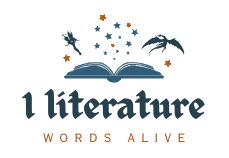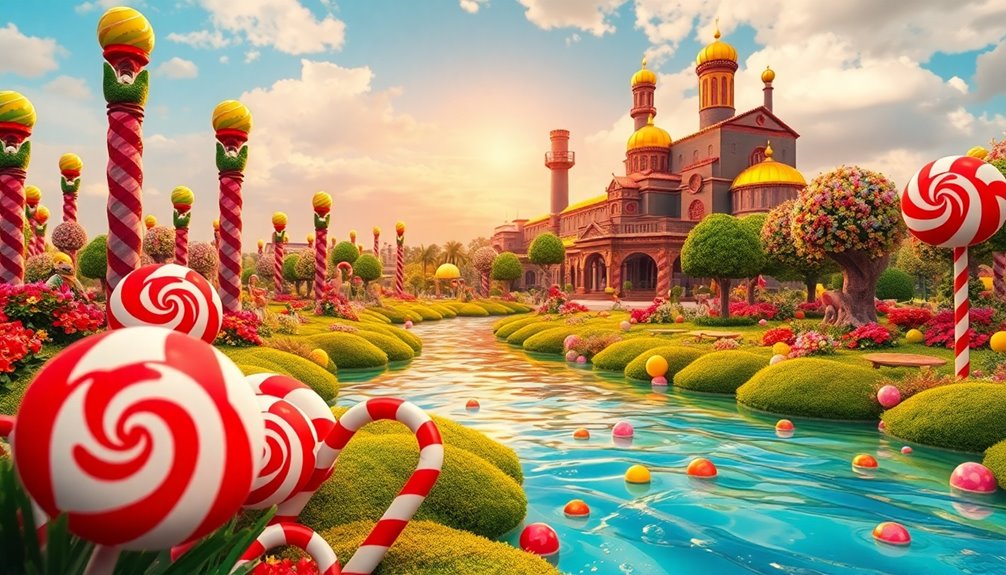You're stepping into the magical domain of "Charlie and the Chocolate Factory," where Charlie Bucket discovers a golden ticket and opens the door to adventure. Each character, from the gluttonous Augustus to the spoiled Veruca, embodies a vice that leads to their downfall. This tale emphasizes the importance of kindness and integrity, contrasting sharply with the consequences of greed. Roald Dahl brings creativity to life within Willy Wonka's whimsical factory, teaching valuable lessons about family, community, and personal growth. If you explore further, you'll uncover even more enchanting insights about this beloved story's depth and impact.
Overview of the Story
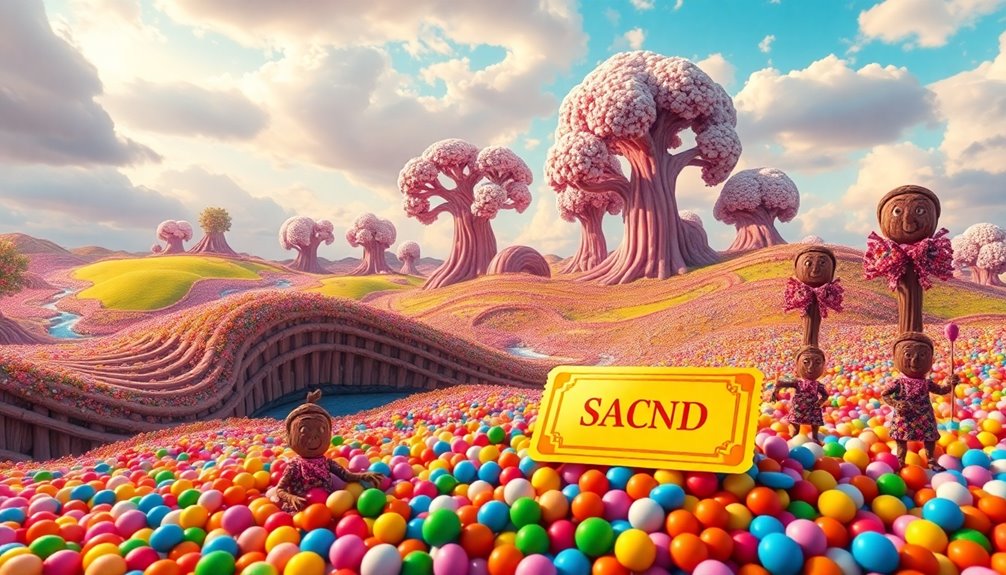
"Charlie and the Chocolate Factory" is an enchanting tale that unfolds the journey of young Charlie Bucket, a boy from a poor family who stumbles upon a golden ticket.
This ticket grants him access to Willy Wonka's whimsical chocolate factory, where he joins four other children, each representing various vices. In this magical realm, the children encounter various mythical creatures that illustrate their character flaws.
As you read, you'll witness Charlie's honesty and kindness shine brightly against the backdrop of greed and bad behavior from his peers, like Augustus Gloop and Veruca Salt.
Their flaws lead to their downfall, while Charlie's virtuous character ultimately earns him the prize: becoming Wonka's heir.
The story delivers a powerful moral lesson about the rewards of integrity, emphasizing that kindness prevails in the face of adversity. Additionally, like Charlie's journey, many characters in literature, such as those in *Unfailing Love*, showcase the importance of redemption and second chances in overcoming personal struggles.
Furthermore, much like the strong female leads in historical fiction who embody resilience and empowerment, Charlie's character illustrates how integrity can triumph over adversity.
Major Themes Explored
As you explore the enchanting world of Willy Wonka's factory, you'll encounter several major themes that enrich the story. Greed stands out starkly, as each flawed child—Augustus, Veruca, Violet, and Mike—faces dire consequences for their selfish desires. The theme of nature as a source of healing resonates with the idea that characters often undergo personal growth through their experiences.
In contrast, kindness and integrity shine through Charlie Bucket, whose virtuous nature ultimately wins Willy Wonka's favor, teaching us that good behavior leads to success. This resonates with the concept of courage and determination found in stories of resilience, where individuals rise above their circumstances.
The narrative also highlights the importance of family and community, with Charlie's supportive relationships contrasting the isolation of the other ticket holders.
Finally, imagination and creativity flourish in the whimsical design of the factory, inspiring you to dream big and embrace extraordinary possibilities. This enchanting tale resonates with the theme of resilience in immigrant communities, illustrating how determination can lead to success against the odds.
These themes combine to craft a rich moral tapestry, enchanting readers young and old.
Character Dynamics
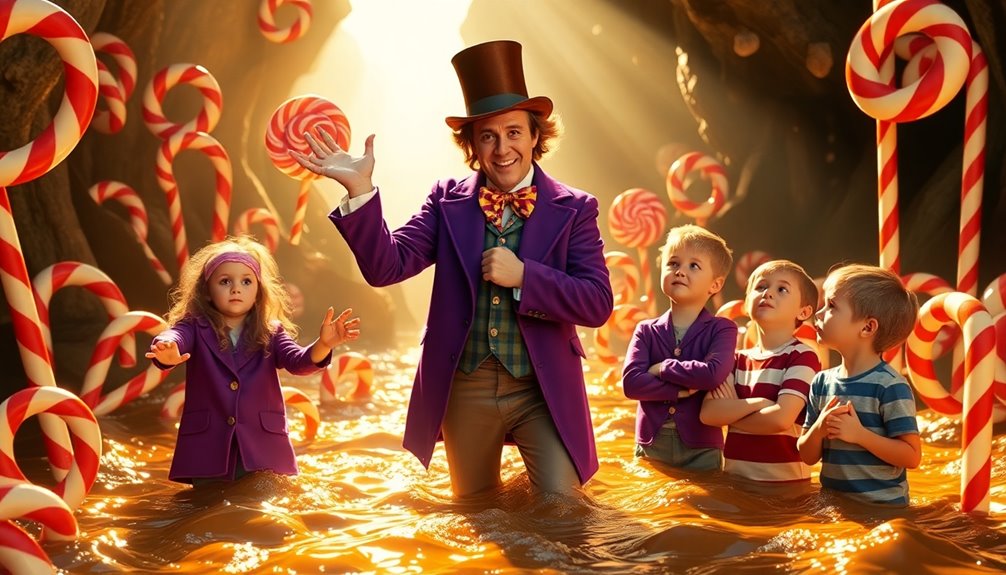
While exploring the vibrant world of Willy Wonka's factory, you'll notice how the character dynamics reveal essential truths about human nature.
Charlie Bucket stands in stark contrast to the other ticket winners, embodying kindness and resilience amid their vices. Augustus Gloop's gluttony leads him to disaster in the Chocolate River, while Veruca Salt's entitlement turns her into a victim of her own spoiled behavior in the Nut Room. This mirrors the totalitarian regimes and control often depicted in dystopian literature, where individual flaws can lead to their downfall in oppressive societies. The rivalry and ambition between the characters further emphasizes the significant consequences of their actions.
Mike Teavee illustrates the perils of technology obsession, dramatically shrinking due to his fixation on screens. Willy Wonka, with his whimsical yet complex nature, interacts with these characters in ways that expose their flaws.
Through these dynamics, the story highlights the consequences of their actions, ultimately emphasizing the virtues embodied by Charlie. This mirrors the journeys of female protagonists in sci-fi literature, who often display bravery and resilience in the face of adversity, inspiring readers to strive for greatness.
Moral Lessons and Values
The journey through Willy Wonka's factory is a rich tapestry of moral lessons, illustrating that true success stems from virtues like kindness and integrity.
Charlie Bucket's character exemplifies how family support and a strong moral compass can lead to happiness, contrasting sharply with the other children who suffer from moral failing. His journey mirrors the personal growth found in stories of individuals overcoming challenges through resilience, much like how Bigger Thomas navigates the oppressive environment shaped by systemic racism.
Augustus, Veruca, Violet, and Mike represent various vices—greed, entitlement, obsession, and gluttony. Their negative outcomes serve as cautionary tales about the dangers of overindulgence and poor behavior.
By highlighting Charlie's humble beginnings and supportive family, the story emphasizes that true wealth isn't found in material possessions but in relationships and good character.
Ultimately, the narrative rewards empathy and community values, showcasing the importance of kindness in achieving fulfillment. Furthermore, the story echoes Liesel's journey in Nazi Germany and the resilience required to navigate through adversity, emphasizing the power of hope and compassion in difficult circumstances.
Imagination and Creativity
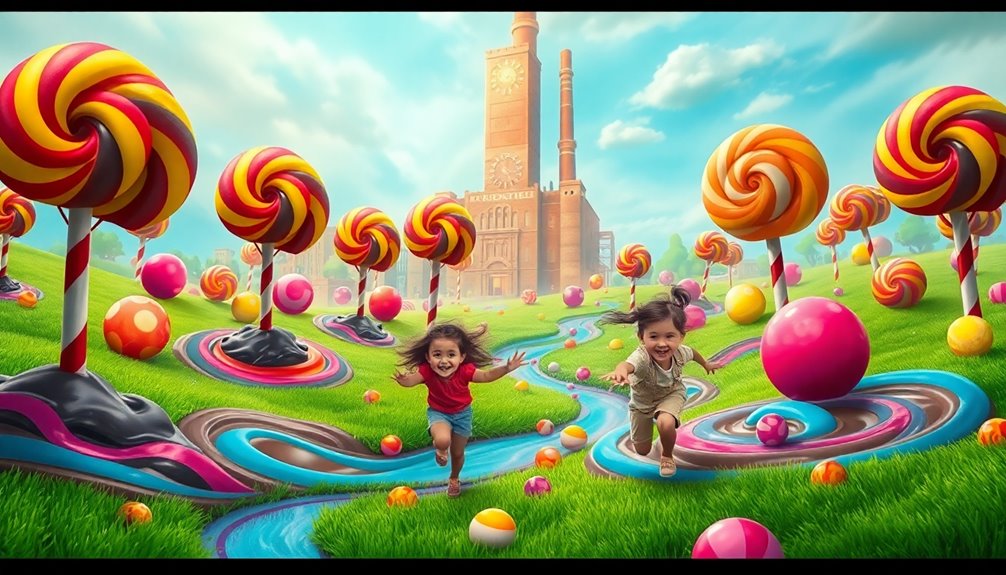
In "Charlie and the Chocolate Factory," you'll see how the power of dreams can turn the ordinary into the extraordinary, especially within the whimsical wonders of Willy Wonka's factory.
As you explore the story, you'll discover how creative problem-solving shapes Charlie's journey and leads him to incredible opportunities. This tale reminds you that imagination isn't just for children—it's an essential tool for anyone willing to dream big. Moreover, it reflects the importance of unity and collaboration as characters work together to overcome challenges and achieve their dreams. The narrative parallels the importance of meaningful connections in enhancing the experiences of those who dare to dream. Additionally, the fantastical elements of the factory echo the role of mythical creatures in enriching narratives, providing a sense of wonder and engagement throughout Charlie's adventure.
Power of Dreams
Imagination fuels the journey through Willy Wonka's factory, transforming ordinary moments into extraordinary adventures. This magical domain showcases the power of dreams and creativity, reminding you that:
- Dreams inspire hope: Charlie Bucket's aspirations for a better life highlight how imagination can uplift us from adversity.
- Creativity creates possibilities: The factory's whimsical designs illustrate that limitless potential exists when you embrace your imaginative side.
- Ambition needs ethics: The children's downfalls serve as a warning against unchecked ambition, emphasizing the importance of a grounded imagination.
Ultimately, the narrative encourages you to nurture your dreams and imagination, reinforcing that creativity can lead to personal growth and positive change in your life.
Whimsical Factory Wonders
Exploring Willy Wonka's factory reveals a world where creativity knows no bounds. Each imaginative room bursts with whimsical elements, sparking your senses and igniting inspiration.
The Chocolate Room captivates with its flowing chocolate waterfall and edible landscapes, inviting you to taste the magic.
Then, step into the Inventing Room, where fantastical machines churn out unique confections, showcasing the joy of innovation.
Every chamber presents delightful surprises that challenge reality, urging you to embrace the wonders of your imagination.
Charlie's journey through this whimsical factory highlights the importance of dreaming big, illustrating how creativity opens doors to limitless possibilities.
These enchanting spaces not only entertain but also impart valuable lessons about the consequences of excess and the magic of imagination.
Creative Problem Solving
While maneuvering through the enchanting chaos of Willy Wonka's factory, you'll quickly realize that creative problem solving is vital for success.
Charlie Bucket's journey highlights how thinking outside the box can lead to innovative solutions. Here are three key aspects of creativity in the narrative:
- Imaginative Storytelling: The factory's rooms brim with whimsical inventions, showcasing how creativity can overcome obstacles.
- Resourcefulness: Charlie's ability to visualize his chocolate dreams demonstrates the power of imagination in navigating challenges.
- Contrast in Characters: The downfall of the other children emphasizes that lack of creativity and overindulgence can lead to failure, while Charlie's kindness and ingenuity shine through.
Embracing creativity and imaginative problem solving is essential in this fantastical world, proving extraordinary results are possible.
Consumerism and Society
In "Charlie and the Chocolate Factory," you see how greed leads to dire consequences for the ticket winners, contrasting sharply with Charlie's humble values.
The story challenges you to think about the balance between imagination and materialism, especially in childhood.
As you explore these themes, you'll uncover the hidden costs of consumer culture in society.
Greed and Consequences
Greed often leads to dire consequences, as vividly illustrated in "Charlie and the Chocolate Factory." Each child's insatiable desire for more—whether it's Augustus Gloop's endless appetite or Veruca Salt's relentless demands—results in immediate and often humorous downfalls during their factory tour.
- Augustus falls into the Chocolate River due to gluttony.
- Veruca is punished for her entitlement by being deemed a "bad nut."
- Mike Teavee shrinks in size from his obsession with technology.
These exaggerated consequences serve as a cautionary tale about the pitfalls of consumerism and indulgence.
Willy Wonka's factory critiques the moral decay tied to unchecked desires, revealing that true wealth lies in kindness and integrity, contrasting with the superficial allure of greed.
Imagination vs. Materialism
As you explore "Charlie and the Chocolate Factory," the stark contrast between imagination and materialism becomes evident.
Charlie's humble nature and rich imagination stand in sharp relief against the materialistic desires of the other ticket winners. Each child embodies a vice linked to consumerism—gluttony, entitlement, competitiveness, and technology obsession—leading to their inevitable downfalls.
Willy Wonka's factory represents the seductive allure of consumer culture, luring children with endless sweets while critiquing their excessive cravings.
The narrative teaches that true wealth lies in moral values, such as kindness and creativity, rather than material possessions.
Through Charlie's journey, you see that imagination triumphs over consumerism, encouraging a deeper reflection on what truly matters in life.
Childhood and Consumer Culture
Though childhood is often seen as a time of innocence and wonder, "Charlie and the Chocolate Factory" reveals how consumer culture can taint that purity.
The story highlights key aspects of consumerism through the experiences of the children:
- Augustus Gloop's gluttony leads to his downfall.
- Veruca Salt's entitlement highlights the dangers of privilege.
- Charlie Bucket embodies kindness and integrity, contrasting with the others.
Willy Wonka's extravagant factory illustrates society's obsession with material goods, while the Oompa-Loompas symbolize the hidden costs of wealth.
The moral lesson becomes clear: true worth comes not from indulgence but from the values of compassion and humility.
Ultimately, Charlie's journey reminds us that life's real treasures lie beyond consumerism.
Family and Community Values
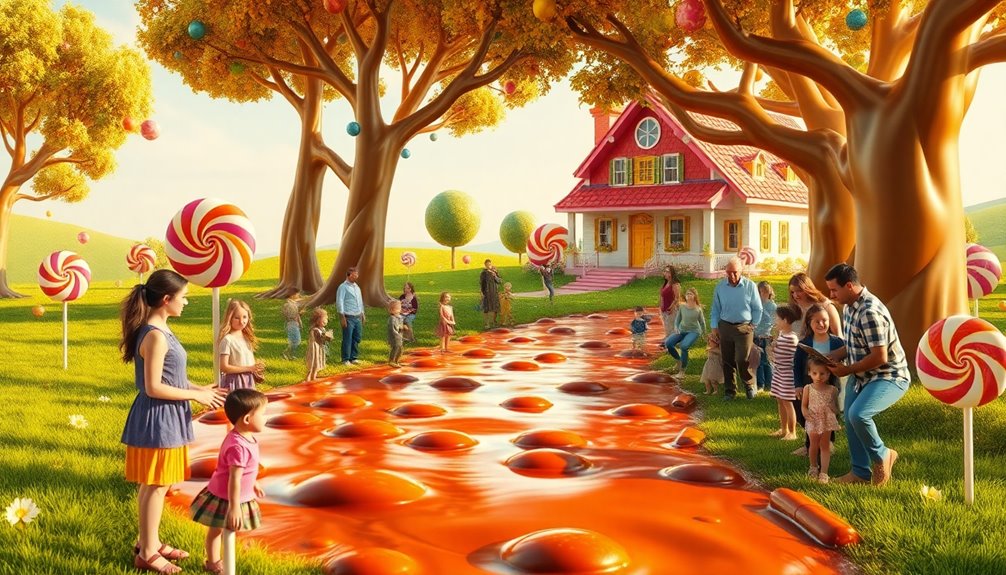
In "Charlie and the Chocolate Factory," the power of love and unity resonates through Charlie Bucket's family dynamics. Despite their poverty, Charlie's family remains tightly-knit, showcasing how mutual support can overcome hardship.
The narrative emphasizes community values through Charlie's interactions with his loved ones and the other ticket winners, highlighting the importance of connection. Grandpa Joe embodies hope and encouragement, inspiring Charlie to persevere even in tough times.
In contrast to the selfish behaviors of the other children, Charlie's humble and kind nature illustrates that true success stems from kindness and caring for others.
Ultimately, the story teaches that prioritizing family and community relationships fosters personal growth and happiness, culminating in Charlie inheriting Willy Wonka's factory.
Artistic Adaptations
When you explore the artistic adaptations of "Charlie and the Chocolate Factory," you'll notice how different productions interpret the story through their unique lenses.
Theatrical interpretations bring fresh dynamics to the narrative, while visual storytelling techniques enhance the magical world of Willy Wonka.
Each adaptation offers a new way to experience this beloved tale, reflecting both the original's charm and contemporary creativity.
Theatrical Interpretation Dynamics
Theatrical adaptations of "Charlie and the Chocolate Factory" bring the beloved story to life by emphasizing its fantastical elements and moral lessons.
You'll experience vibrant choreography, original songs, and exaggerated character portrayals that enhance your connection to the narrative.
Here are three standout features:
- Imaginative Set Designs: Picture the Chocolate Room with its mesmerizing chocolate waterfall and candy landscapes, transporting you into Willy Wonka's whimsical factory.
- Dynamic Performances: Characters like Augustus Gloop and Veruca Salt come alive, showcasing their vivid traits to highlight important moral lessons.
- Multimedia Elements: Enhanced lighting and sound effects make pivotal moments, like the factory tour, even more enthralling, pulling you deeper into the story's magic.
Visual Storytelling Techniques
Visual storytelling techniques in artistic adaptations of "Charlie and the Chocolate Factory" create a mesmerizing experience that immerses you in Willy Wonka's enchanting world.
You'll notice the vibrant colors and whimsical designs that set the tone, making the factory feel alive. Each set, like the Chocolate Room with its flowing chocolate river, showcases fantastical elements that enhance the narrative's sensory richness.
Costume design differentiates characters effectively; for example, Augustus Gloop's oversized clothing symbolizes his gluttony.
Lighting techniques contrast Charlie's dreary home with the factory's bright spaces, reinforcing themes of hope and wonder.
Animation and visual effects breathe life into Wonka's quirky inventions, engaging you with imaginative visuals that capture the essence of creativity and excess throughout the story.
Impact on Children's Literature

"Charlie and the Chocolate Factory" has left a significant mark on children's literature since its publication in 1964. Roald Dahl's whimsical storytelling and vivid imagery not only entertain but also provoke thought about important themes.
Here are three ways it impacts young readers:
- Moral Lessons: The story teaches kindness, integrity, and the consequences of greed, prompting ethical discussions among children.
- Character Archetypes: Its engaging characters have influenced modern storytelling, setting a standard for relatable figures in children's media.
- Cultural Relevance: The novel sparks critical analyses, expanding its reach beyond mere entertainment into educational discussions.
Through Charlie's adventure, Dahl's work continues to shape the landscape of children's literature, enchanting generations with its timeless messages.
Analysis of Willy Wonka
Willy Wonka stands out as one of the most intriguing characters in children's literature, embodying both whimsy and complexity. As the eccentric owner of a magical chocolate factory, he captivates you with his creativity and innovation.
However, his motives are often ambiguous. You'll notice he seeks an heir while simultaneously testing the virtues of the golden ticket winners. He rewards Charlie's kindness and honesty, contrasting sharply with the other children's flaws, which he punishes.
This duality reflects a deeper backstory, marked by a troubled relationship with his father. Additionally, the Oompa-Loompas raise ethical questions about colonial exploitation, adding layers to Wonka's whimsical world.
Ultimately, you see a character filled with contradictions, making him endlessly fascinating.
Lessons From Each Character
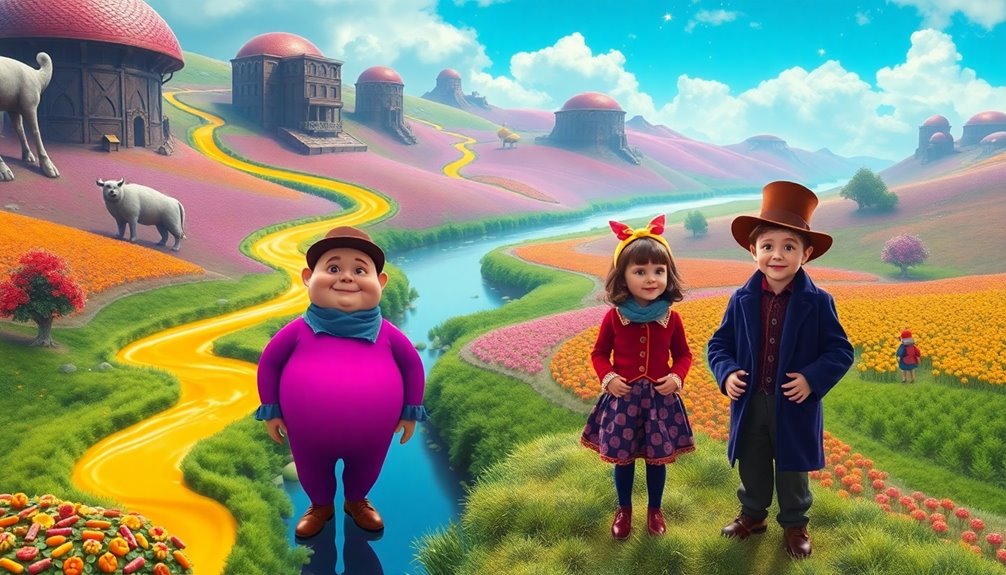
While exploring the vibrant world of Willy Wonka's factory, you'll discover that each character teaches valuable lessons about human behavior and morality.
Here are three key takeaways:
- Charlie Bucket: His kindness and humility show that selflessness can lead to great rewards, as he becomes Wonka's heir through honesty.
- Augustus Gloop: Representing gluttony, he illustrates the dangers of overindulgence. His lack of self-control serves as a warning against excess.
- Veruca Salt: Symbolizing entitlement, she exemplifies the pitfalls of selfishness. Her demanding behavior highlights the importance of valuing others over oneself.
These characters remind us of the virtues we should embrace and the flaws we should avoid in our own lives.
Legacy of Roald Dahl
Roald Dahl's legacy is a tribute to the power of imagination and storytelling. His work, particularly 'Charlie and the Chocolate Factory,' has become a cornerstone of children's literature, enchanting readers since its 1964 release.
Through imaginative narratives and moral lessons, Dahl explores themes like greed and kindness, resonating with both kids and adults. His unique style, filled with playful prose and vivid imagery, guarantees his tales remain relevant and engaging.
Adaptations into films and stage productions further solidify Dahl's cultural impact, influencing modern storytelling and character archetypes.
Today, educators celebrate his stories, using them to spark discussions on ethics and childhood complexities. Roald Dahl's legacy continues to thrive, inspiring generations to dream and imagine beyond boundaries.
Conclusion
In the vibrant, candy-coated world of "Charlie and the Chocolate Factory," you can almost taste the sweet, swirling river of chocolate and feel the magic of imagination bubble around you. Roald Dahl weaves a tale that not only delights but also imparts timeless lessons. As you step away from this fantastical journey, remember the complexities of each character and the values they represent. They invite you to dream big, embrace creativity, and cherish the simple joys of life.
